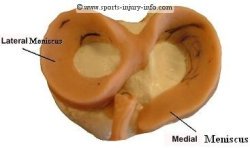Meniscus Tear Symptoms: Loss of Motion
Of all the meniscus tear symptoms, loss of motion in the knee is one that can be very frustrating. After all, it is your knee...and not being able to bend it can be awful. What causes the loss of motion? Glad you asked...Swelling is the Culprit
In the initial days after a meniscus tear, the symptoms of swelling and pain contribute to the loss of motion. Swelling is caused by the initial injury, and that limits your motion by producing a very tight joint, and pain.Swelling causes the knee joint capsule to distend, or be very stretched. The fluid fills up the joint, and it feels very tight. You can see this just by looking at the knee...it looks like a grapefruit. With the joint being very tight, there is a lot of pressure on all of the tissues, and this excites and stimulates all of the nerve receptors...and this causes pain. When you move your knee to bend it, it increases the pressure within the joint, and it causes pain. So pain, caused by swelling, limits your range of motion.
Mechanical Restrictions
The other factor that can limit your range of motion is the torn portion of the meniscus. While the torn piece of the meniscus is not one of the specifc meniscus tear symptoms, it can cause quite a bit of problems. When the meniscus tears, there may be a portion of it that becomes mobile.
Other times, it restricts the motion, and you are unable to bend, or straighten the knee. Loss of motion because of mechanical restrictions usually isn't really apparent until the swelling has gone down some, and your knee is less painful.
Summary
Loss of motion is a signficant symptom, and is a result of swelling, and possibly mechanical restrictions. Swelling will subside over time with proper treatment. Mechanical restrictions usually have to be treated surgically.Didn't find what you were looking for? Search SII for more information...
Running Pain Solutions
Written for Runners by a runner, you'll learn a holistic approach to improving mobility, restoring normal movement and muscle activation patterns, and restoring the body and mind connection.
This Kindle Book contains a step by step program to keep you running pain free. Included are detailed instructions and illustrations for exercises to improve mobility, balance, neuromuscular control, strength and endurance. Only $7.49!
Get Your Copy Today!









